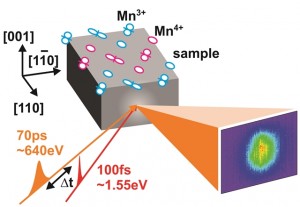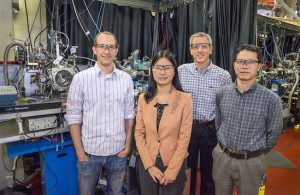
Ultrafast pulses of x-rays from Berkeley Lab’s Advanced Light Source revealed a glass-like re-ordering of electron-spin states in PCMO crystals as samples recovered from a photo-excited conductor state back to the insulator state. In this schematic, circles and lobes show manganese sites and orbitals with pink and blue colors representing opposite spin orientations
Manganites – compounds of manganese oxides – show great promise as “go-to” materials for future electronic devices because of their ability to instantly switch from an electrical insulator to a conductor under a wide variety of external stimuli, including magnetic fields, photo-excitations and vibrational excitations. This ultrafast switching arises from the many different ways in which the electrons and electron-spins in a manganite may organize or re-organize in response to such external stimuli. Understanding the physics behind these responses is crucial for the future development of manganites.
In a recent study of praseodymium calcium manganite (PCMO) crystals, a model manganite system, researchers at Lawrence Berkeley National Laboratory (Berkeley Lab) discovered that under photo-stimulation the insulator/conductor switching, which depends primarily on charge-ordering, may be ultra-fast, but the re-ordering of electron-spin, upon which magnetic properties depend, is not. In fact, the re-ordering of spin in these materials actually exhibits a glass-like state, in which the restoration of crystalline order is substantially delayed.
“The electron-spins get trapped in a frustrated, disordered state, like cars trying to merge without road signs or lane markers, and can take multiple seconds, a comparatively very long time, to sort themselves out,” says Robert Schoenlein of Berkeley Lab’s Materials Sciences Division, one of the leaders of this study. “This separation of charge-ordering behavior from spin-ordering behavior may point the way to new approaches to manipulating spin effects for applications in switching and memory devices.”

(From left) Matthew Langner, Shuyun Zhou, Robert Schoenlein and Yi-De Chuang used Advanced Light Source (ALS) Beamline 6.0.2 to study insulator/conductor switching of a PCMO manganite crystal under photo-stimulation. (Photo by Roy Kaltschmidt)
Working at beamline 6.0.2 of Berkeley Lab’s Advanced Light Source (ALS), Schoenlein and a team that included Shuyun Zhou and Yi-De Chuang probed spin-ordering in PCMO crystals using a technique called time-resolved resonant soft x-ray scattering spectroscopy (TR-RSXS). In this technique, they pelted PCMO samples with 70 picosecond (trillionths of a second) pulses of x-rays to capture a series of snapshots that revealed how electron-spin ordering is re-established as the samples recover from a photo-excited conductor state back to the insulator state.
“We found that the glass-like behavior of the electron-spins arise from the metastable state created by photo-excitation, a state characterized by spin disordered metallic droplets within the larger charge- and spin-ordered insulating domains,” says ALS staff scientist Chuang. “Comparison with time-resolved resistivity measurements suggests that the collapse of spin ordering is correlated with the insulator-to-metal transition, but the recovery of the insulating phase does not depend on the re-establishment of the spin ordering.”
Adds Zhou, “Our work provides a new perspective for revealing the fascinating physics hidden in the recovery dynamics of electronic ordering in correlated electron materials after transient photo-excitation, a prominent method for ultrafast manipulation of material properties. Since other transition metal oxides that exhibit intriguing emergent phenomena, such as the high-temperature superconducting cuprates, also have rich competing phases involving dynamic electronic orderings, we should be able to extend similar TR-RSXS studies to those systems as well.”
A paper reporting this research has been published in the journal Scientific Reports. The paper is entitled “Glass-like recovery of antiferromagnetic spin ordering in a photo-excited manganite Pr0.7Ca0.3MnO3.” Schoenlein, Chuang and Zhou are the corresponding authors.
Additional Information
For more about Berkeley Lab’s Advanced Light Source go here